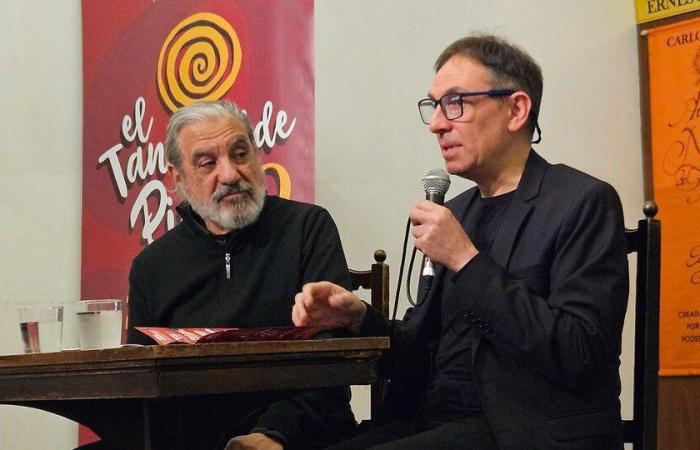
He Tuesday July 2 he returns cycle The tango asks for a trackthe annual meeting that for a month takes the stage (and the sidewalk) of Urban Track (Chacabuco 874) to highlight a comprehensive map of the contemporary tango circuit. Is about 28 shows –which includes many to the cap- that will begin with the film screening Teachers’ Coffee (by Miguel Kohan, with production by Gustavo Santaolalla, Lita Stantic and Walter Salles) and the presentation of Random Nightfrom Shipyard. Then the programme will continue until July 30th and, except for dance, it will cover the different aspects of the genre, from those who cover classics to those who seek to renew the repertoire, those who propose experimental options and those who contribute from the theatre. The organisers propose it as “a celebration of Rioplatense music” and they define the route as “a meeting with friends, neighbours, spectators: the usual pisteurs and those who are encouraged to do it for the first time”.
“At the time I had the desire to create this special cycle of diffusion of tango, in all its expressions, to keep the genre alive in the city and also spread it on the networks,” he says. Jorge Sabatoarchitect, visual artist, singer and “passionate citizen” of Buenos Aires, but also Head of Urban Track.
The cycle comes at a very sensitive time for culture in the entire country, hit not only by the sector-specific measures taken by the government headed by Javier Milei, but also by the impact of its macroeconomic policies on the general situation of culture consumers. “The tango industry has had to relocateregenerate in different places such as cultural centers, music clubs, which are finally places where they have a maximum capacity of 200, some 300,” says Sábato.
In this sense, Sábato considers that the role of Pista Urbana (which operates as non-profit cultural association) should be “to continue to spread these musics throughout the year and generate a strengthening in what is the sector of the diffusion of our culture”. The person in charge of the space points out that they have already been active for a decade “with many difficulties but with a lot of energy and conviction”
For this edition, the call is focused on those who have accompanied the space in recent years, although there are also some new additions to its lineup. Some have been there for years, such as Alfredo Piro, Luis Filippelli or Lautaro Mazza“They are artists with a long-term vision, with support from our local music promotion,” explains the manager. “We add those who can also generate renewal for some places, because we have to give them that opportunity to express themselves and renew the agenda a little.”
About the decision of do many of the shows at the capSábato points out that the measure arose during the pandemic. “It was a way to cover the performances of the different shows on the street, because we couldn’t do any kind of presentation inside the venue, but we did have permission to close the street on Thursdays, Fridays and Saturdays, and it turned out to be a very interesting alternative.”
“The cap is also a democratic way of being able to offer this type of shows of different genres. In The tango asks for a clue The closing is on the street, it always was, and it is also a cap, but by a decision also agreed with the musicians. Sometimes the cap really offers alternatives that perhaps a ticket today, with the situation we are having, is much more accessible for an audience that cannot see a show, because perhaps they cannot afford to pay the price of the ticket. We believe that democratically everyone has the right to see a show, and we do not put a minimum consumption, so if someone wants to go, not put the cap and not drink anything, they can do that too. But the cap always has its possibility for the public and even if it is a minimal contribution, it is present, because there is always someone who is going to put, even if it is something similar to what a ticket could be. That is the reason and although it is not as generalizable as it was in times of the pandemic, today it is still valid and agreed with the artists.
This year’s proposal opens with the Astillero, which already has an established cycle in that setting. A rarity, a cycle that attracts, not for export, in the current context. “We allocate that day for those who play without being plugged in, because we have a venue with the acoustic conditions to not have to resort to assisted sound. They develop a tango with a very important and very innovative contemporary proposal, and the way they handle the public is very special. The fact that they do not play in another space is very important because people know that, if they want to see and hear them, they are only in Pista Urbana. It is their decision and for us it is very important because this circumstance guarantees a permanent audience.”
In addition, the cycle The tango asks for a clue will also participate Mario Cardenas, Gabriela Novaro and Hernan Reinaudo, The Cut Outs, Mariana Mazú, Cardinal DominguezViviana Scarlassa, the Ranas duo, Alex Musatov, César Angeleri with his quartet, Lautaro Mazza, Alfredo Piro, Patricia Malanca, the Color Tango orchestra and others.





